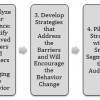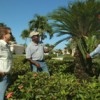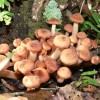 Needs and assets assessments are a key task for Extension agents because they aid the development and delivery of research-based programs that address local needs. The purpose of this article is to describe the process of identifying key leaders to support an Extension agent’s needs assessment activities through interviews. This 4-page fact sheet was written by Laura A. (Sanagorski) Warner and Sebastian Galindo-Gonzalez, and published by the UF Department of Agricultural Education and Communication, May 2014.
Needs and assets assessments are a key task for Extension agents because they aid the development and delivery of research-based programs that address local needs. The purpose of this article is to describe the process of identifying key leaders to support an Extension agent’s needs assessment activities through interviews. This 4-page fact sheet was written by Laura A. (Sanagorski) Warner and Sebastian Galindo-Gonzalez, and published by the UF Department of Agricultural Education and Communication, May 2014.
http://edis.ifas.ufl.edu/wc164
Tag: Laura Sanagorski
Using Social Norms to Increase Behavior Change in Sustainable Landscaping
 When Extension agents work to encourage behavioral changes in their community through educational programming, they may already be using some elements of social marketing. Extension educators can use an understanding of their clients’ reservations and inclinations toward a behavior, or their benefits and barriers, to develop strategies that encourage behavior change. Common strategies include prompts and reminders, incentives, and changing social norms. These strategies may be piloted on a small scale, modified if necessary, and then implemented on a large scale and further evaluated. This publication’s purpose is to describe the use of social norms as a social marketing strategy and make recommendations for applying social norms as a tool in Extension programming. This 5-page fact sheet was written by Laura Sanagorski and Paul Monaghan , and published by the UF Department of Agricultural Education and Communication, February 2014.
When Extension agents work to encourage behavioral changes in their community through educational programming, they may already be using some elements of social marketing. Extension educators can use an understanding of their clients’ reservations and inclinations toward a behavior, or their benefits and barriers, to develop strategies that encourage behavior change. Common strategies include prompts and reminders, incentives, and changing social norms. These strategies may be piloted on a small scale, modified if necessary, and then implemented on a large scale and further evaluated. This publication’s purpose is to describe the use of social norms as a social marketing strategy and make recommendations for applying social norms as a tool in Extension programming. This 5-page fact sheet was written by Laura Sanagorski and Paul Monaghan , and published by the UF Department of Agricultural Education and Communication, February 2014.
http://edis.ifas.ufl.edu/wc158
Impatiens Downy Mildew
 Downy mildew on impatiens is of great concern throughout Florida. Winters in south Florida provide high humidity paired with cool nights, creating ideal conditions for disease development. Downy mildews are caused by several different species of pathogens that tend to be plant-host specific. Plasmopara obducens is the pathogen that affects impatiens. Some literature indicates that nighttime temperatures of about 50 to 72°F favor downy mildew, but the disease has been reported on impatiens year round in south Florida. This 4-page fact sheet was written by L. Sanagorski, B. Schall, A.J. Palmateer, and N.A. Peres, and published by the UF Department of Plant Pathology, October 2013.
Downy mildew on impatiens is of great concern throughout Florida. Winters in south Florida provide high humidity paired with cool nights, creating ideal conditions for disease development. Downy mildews are caused by several different species of pathogens that tend to be plant-host specific. Plasmopara obducens is the pathogen that affects impatiens. Some literature indicates that nighttime temperatures of about 50 to 72°F favor downy mildew, but the disease has been reported on impatiens year round in south Florida. This 4-page fact sheet was written by L. Sanagorski, B. Schall, A.J. Palmateer, and N.A. Peres, and published by the UF Department of Plant Pathology, October 2013.
http://edis.ifas.ufl.edu/pp309
Using Audience Commitment to Increase Behavior Changes in Sustainable Landscaping
 Participants in an Extension rain barrel workshop who said they would inspect their irrigation systems might begin to see themselves as people who use water wisely. Their perception of themselves as conservationists is strengthened with each new action. That makes them more likely to agree to an action that leads to an even bigger water savings. Research has shown that commitments can increase the percentage of people who will adopt a new behavior and give up an old one. This 4-page fact sheet was written by Laura A. Sanagorski and Paul Monaghan, and published by the UF Department of Agricultural Education and Communication, September 2013.
Participants in an Extension rain barrel workshop who said they would inspect their irrigation systems might begin to see themselves as people who use water wisely. Their perception of themselves as conservationists is strengthened with each new action. That makes them more likely to agree to an action that leads to an even bigger water savings. Research has shown that commitments can increase the percentage of people who will adopt a new behavior and give up an old one. This 4-page fact sheet was written by Laura A. Sanagorski and Paul Monaghan, and published by the UF Department of Agricultural Education and Communication, September 2013.
http://edis.ifas.ufl.edu/wc154
Incorporating Individual Teachings (aka Individual Contact Teaching Methods) into a Sustainable Landscaping Extension Plan of Work and Report of Accomplishment
 Many horticultural Extension professionals conduct numerous consulting phone calls, send e-mails, visit offices, conduct research, and visit landscapes to solve horticultural problems and concerns. Although many Extension faculty members are initially unaware that they are educating clients when providing these services, these activities shouldbe considered major educational methods. The activities should also be planned by Extension faculty and reported in an Extension plan of work and in their annual report of accomplishments. When planned thoughtfully, communicated clearly, and evaluated appropriately, these methods of individual contact teaching can become a substantial part of an Extension program. This 4-page fact sheet was written by Laura Sanagorski, and published by the UF Department of Agricultural Education and Communication, November 2013.
Many horticultural Extension professionals conduct numerous consulting phone calls, send e-mails, visit offices, conduct research, and visit landscapes to solve horticultural problems and concerns. Although many Extension faculty members are initially unaware that they are educating clients when providing these services, these activities shouldbe considered major educational methods. The activities should also be planned by Extension faculty and reported in an Extension plan of work and in their annual report of accomplishments. When planned thoughtfully, communicated clearly, and evaluated appropriately, these methods of individual contact teaching can become a substantial part of an Extension program. This 4-page fact sheet was written by Laura Sanagorski, and published by the UF Department of Agricultural Education and Communication, November 2013.
http://edis.ifas.ufl.edu/wc157
Repackaging as a Strategy to Increase Efficiency in Extension Programs
 Repackaging is a way to reuse the research and writing one has done on a particular topic by formatting it in multiple formats for several audiences. It can be used as a strategy to reach a greater variety of audiences with fewer resources. This 3-page fact sheet was written by Laura A. Sanagorski, and published by the UF Department of Agricultural Education and Communication, October 2013.
Repackaging is a way to reuse the research and writing one has done on a particular topic by formatting it in multiple formats for several audiences. It can be used as a strategy to reach a greater variety of audiences with fewer resources. This 3-page fact sheet was written by Laura A. Sanagorski, and published by the UF Department of Agricultural Education and Communication, October 2013.
http://edis.ifas.ufl.edu/wc155
Armillaria Root Rot (Also known as Mushroom Root Rot, Shoestring Root Rot, Honey Mushroom Rot)
 Armillaria root rot is a disease that decays the root system of many common trees and shrubs. It is caused by several species of Armillaria, fungi that can be recognized by the clusters of yellow to honey-colored mushrooms that emerge during moist conditions. The disease is often lethal, and infected trees may have wilting branches, branch dieback, and stunted growth. Infected trees and shrubs should be removed and replaced with resistant species. This 4-page fact sheet was written by Laura Sanagorski, Aaron Trulock, and Jason Smith, and published by the UF Department of Environmental Horticulture, July 2013.
Armillaria root rot is a disease that decays the root system of many common trees and shrubs. It is caused by several species of Armillaria, fungi that can be recognized by the clusters of yellow to honey-colored mushrooms that emerge during moist conditions. The disease is often lethal, and infected trees may have wilting branches, branch dieback, and stunted growth. Infected trees and shrubs should be removed and replaced with resistant species. This 4-page fact sheet was written by Laura Sanagorski, Aaron Trulock, and Jason Smith, and published by the UF Department of Environmental Horticulture, July 2013.
http://edis.ifas.ufl.edu/ep478